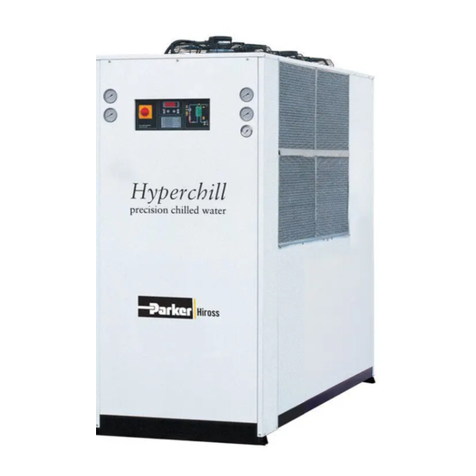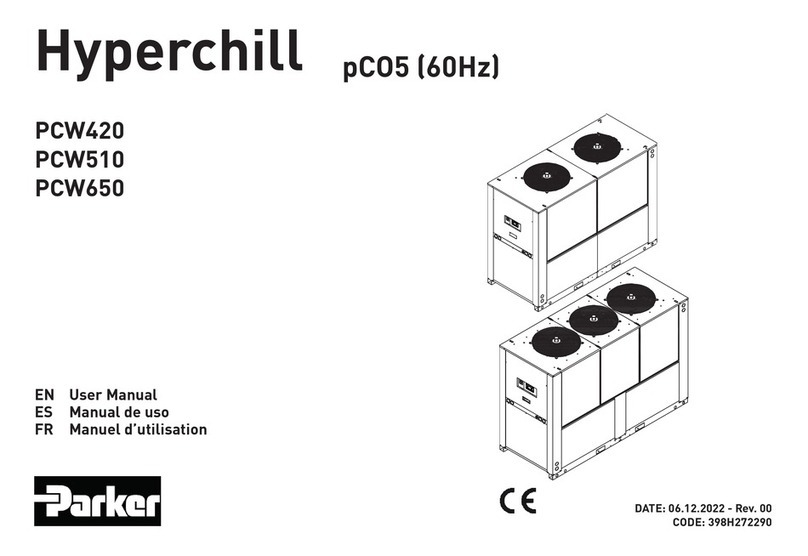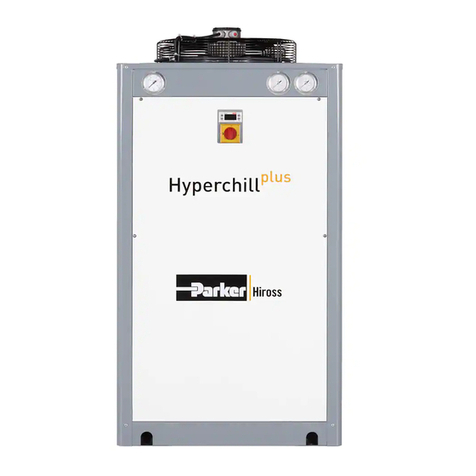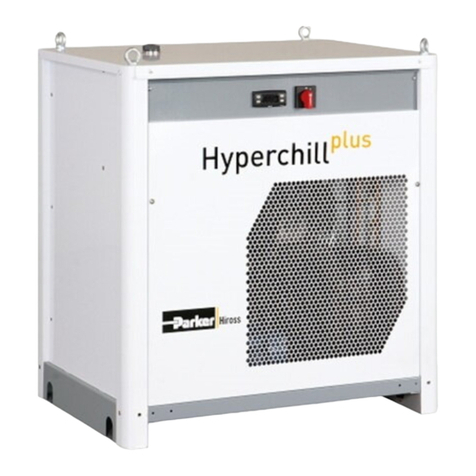
Italiano 3 / 8
ICEP040-060
c) Aggiungere un’adeguata quantità di antigelo all’acqua di circolazio-
ne (vedi tabella).
A volte la temperatura dell’acqua in uscita è tale da richiedere che essa
venga miscelata con glicole etilenico, per evitare formazioni di ghiaccio,
nelle percentuali sotto riportate.
Temperatura acqua
in uscita [°C]
Glicole etilenico
(% vol.)
Temperatura
ambiente
45-2
210-5
015-7
-2 20 -10
-4 25 -12
-6 30 -15
3.3.3 Vaso d’espansione
Per evitare che gli aumenti o diminuzioni di volume del uido con-
seguenti ad una variazione sensibile della sua temperatura possano
danneggiare la macchina o il circuito, è consigliabile installare un vaso
d’espansione di capacità adeguata.
Il vaso d’espansione va installato in aspirazione alla pompa sull’attacco
posteriore del serbatoio.
Per un calcolo del volume del vaso d’espansione da applicare ad un
circuito chiuso si può utilizzare la formula seguente:
V=2 x Vtot x (Pt min - P t max)
dove
Vtot= vol. totale del circuito (in litri)
P t min/max = peso specico alla minima/massima temperatura rag-
giungibile dall’acqua [kg/dm3].
I valori di peso specico in funzione della temperatura e della percen-
tuale di glicole, sono riportati in tabella.
%
glicole
Temperatura [°C]
-100 1020304050
0% 1.0024 1.0008 0.9988 0.9964 0.9936 0.9905 0.9869
10% 1.0177 1.0155 1.0130 1.0101 1.0067 1.0030 0.9989
20% 1.0330 1.0303 1.0272 1.0237 1.0199 1.0156 1.0110
30% 1.0483 1.0450 1.0414 1.0374 1.0330 1.0282 1.0230
!Attenzione: In fase di riempimento fare riferimento ai dati di
carica anche del vaso di espansione.
Se la temperatura dell’aria ambiente attorno al refrigeratore è
inferiore a -10°C, è necessario spostare il vaso di espansione in un
ambiente protetto vicino sul lato di ritorno dell’acqua del refrigera-
tore. La valvola di sicurezza e la valvola di sfiato devono rimanere
sul refrigeratore.
3.4 Circuito elettrico
3.4.1 Controlli e collegamenti
!Prima di effettuare qualsiasi operazione su parti elettriche assicu-
rarsi che non vi sia tensione.
Tutte le connessioni elettriche devono essere conformi alle prescrizioni
locali del luogo di installazione.
Controlli iniziali
1) La tensione e la frequenza di rete devono corrispondere ai valori
stampigliati sulla targhetta dati del refrigeratore. La tensione di
alimentazione non deve, neppure per brevi periodi, essere fuori dalla
tolleranza riportata sullo schema elettrico che, salvo diverse indica-
zioni, è pari +/- 10% per la tensione; +/- 1% sulla frequenza.
2) La tensione deve essere simmetrica (valori efcaci delle tensioni ed
angoli di fase fra fasi consecutive uguali fra loro). Il massimo squili-
brio ammesso fra le tensioni è pari al 2%.
Collegamento
1) L’alimentazione elettrica dei refrigeratori viene effettuata con cavo a
4 li , 3 poli +terra, senza neutro. Per la sezione vedere paragrafo 7.3.
2) Passare il cavo attraverso il pressacavo posto sul pannello posterio-
re della macchina e collegare fase e neutro ai morsetti del seziona-
tore generale (QS), la terra va collegata all’apposito morsetto di terra
(PE).
3) Assicurare all’origine del cavo di alimentazione una protezione con-
tro i contatti diretti pari ad almeno IP2Xo IPXXB.
4)Installare , sulla linea di alimentazione elettrica del refrigeratore, un
interruttore automatico con differenziale (RCCB - IDn = 0.3A), della
portata massima indicata nello schema elettrico di riferimento, con
potere di interruzione adeguato alla corrente di corto circuito esisten-
te nella zona d’installazione della macchina.
La corrente nominale “In” di tale magnetotermico deve essere uguale
a FLA e la curva di intervento di tipo D.
5) Valore massimo dell’impedenza di rete = 0.274 ohm.
Controlli successivi
Assicurarsi che la macchina e le apparecchiature ausiliarie siano state
messe a terra e protette contro cortocircuiti e/o sovraccarichi.
!Una volta che l’unità è stata collegata e l’interruttore generale a
monte è stato chiuso (dando così tensione alla macchina), il voltaggio
nel circuito elettrico raggiunge valori pericolosi. Massima precauzione!
3.4.2 Allarme generale
Tutti i refrigeratori sono provvisti della segnalazione allarme macchina
(vedere schema elettrico), costituita da un contatto libero in scambio
riportato in morsettiera: ciò permette di allacciare un allarme centraliz-
zato esterno, acustico, visivo o inserito in logiche es. PLC.
3.4.3 ON/OFF remoto
Tutti i refrigeratori hanno la possibilità di avere un comando di avvia-
mento e fermata remoto (par.7.3):
- Per abilitare il remoto rif. n.16387
- Per variabile di riferimento ON/OFF rif.n.8996
Nota: non abilitare “Sup” e “Re” insieme.
Per il collegamento del contatto ON-OFF remoto vedere lo schema
elettrico (par. 7.7).
3.5 Versione ventilatori assiali ad alta prevalenza (C)
Utilizzata quando si vuole poter canalizzare l’aria calda proveniente
dalla condensazione.
I ventilatori assiali ad alta prevalenza hanno la capacità di imprimere
all’aria una pressione statica utile tale da vincere le perdite di carico
derivanti da una canalizzazione.
Attenzione: le unità dotate di questi ventilatori non possono essere
installate in aria libera, senza canalizzazione. I ventilatori , per funzio-
nare correttamente, necessitano di una contropressione minima tale
da impedire un ”fuori giri” del motore elettrico ed una sua conseguente
rottura.
Regole di canalizzazione
1) Ogni ventilatore dev’essere canalizzato singolarmente: i ventilatori
devono avere la possibilità di lavorare in maniera indipendente.
2) Le canalizzazioni devono avere supercie di passaggio dell’aria pari
a quelle dei ventilatori montati sull’unità.
!Attenzione: Massima perdita di carico = 130 Pa.
3.6 Versione con condensazione ad acqua (W)
I chiller in versione con condensazione ad acqua, necessitano di un
circuito idraulico che porti l’acqua fredda al condensatore.
Il chiller in versione ad acqua è dotato di una valvola pressostatica, in
entrata al condensatore, la cui funzione è quella di regolare la portata
d’acqua in modo da ottenere sempre una condensazione ottimale.
Controlli preliminari
Se l’alimentazione di acqua al condensatore viene realizzata tramite cir-
cuito chiuso, effettuare tutti i controlli preliminari elencati per il circuito
idraulico principale (paragrafo 3.3.1).
Collegamento
1) Si consiglia di dotare il circuito acqua di condensazione di valvole di
intercettazione, in modo da poter escludere la macchina in caso di
manutenzione.
2) Collegare le tubazioni di mandata/ritorno acqua agli appositi attac-
chi posti sul retro dell’unità.
3) Se l’acqua di condensazione è “ a perdere”, si consiglia di dotare il
circuito di un ltro in ingresso al condensatore, in modo da limitare il
rischio di sporcamento delle superci.
4) Se il circuito è di tipo chiuso, vericare che sia ben riempito d’acqua
e correttamente satato dall’aria.


































